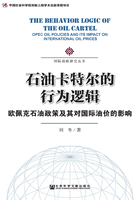
三 思路与框架
欧佩克被认为是石油市场的卡特尔组织。与其他卡特尔一样,欧佩克影响油价的能力会受到一系列主客观因素的制约。本书以市场结构和卡特尔组织机制对卡特尔的影响作为分析的出发点,搭建了一个卡特尔理论的分析框架,从主客观两个方面来分析欧佩克的油价影响力和市场属性。不过,由于石油是一种具有政治属性的地租商品,仅仅依靠经济学理论仍难以得出欧佩克影响油价所需的具体能力。因此,本书将超越经济学理论,走入地缘政治的视野,将地缘政治因素融合进卡特尔理论的分析框架。也就是说,将地缘政治因素对石油市场、欧佩克卡特尔机制的影响融合到卡特尔理论的分析框架之中。
本书总共分为6章。
第一章是导言。在导言部分,笔者简单介绍了本书的由来和意义、研究现状、思路与框架。在本章,笔者从供给、需求和地缘政治三个方面对国际油价的研究成果进行梳理。
第二章是国际油价的构成及其波动。国际油价由石油生产价格、石油地租和垄断收益构成。石油价格的构成除会受到油田资源地质条件差异的影响外,也会受到国际油价变动的影响。一般来说,油田资源地质条件越好、国际油价越高,地租收益在油价中所占比例也就越高。在油价波动方面,因为石油供给和短期石油需求都是极其缺乏弹性的,国际石油供求的短期变化往往会带来国际油价的大幅波动。此外,由于石油供求的价格弹性在长期也相对缺乏,石油供求的长期变化往往易于带来国际油价趋势性、结构性的变化。
第三章是欧佩克的目标与政策。本章对欧佩克的目标以及1973年至今欧佩克执行过的石油政策进行梳理和分析。经分析得出,欧佩克设定的目标虽有很多,但其核心目标是要维护产油国利益。为实现这一目标,欧佩克不断对其石油政策进行调整。1973年至今,欧佩克总共执行过四大战略:“提价保值”战略(1973~1981年)、“限产保价”战略(1981~1985年)、“低价保额”战略(1986~2004年),以及“维持市场适度紧张”战略(2005年至今)。从欧佩克石油政策的演变来看,欧佩克政策中的油价目标也在不断弱化,从最初的直接固定价格(1973~1985年),到后来通过产量调整间接影响价格(1986~2004年),最后变为当前的、以石油供求为目标的、放弃对油价的干预(2005年至今)的价格目标。
第四章是欧佩克油价影响力的因素分析。本章综合利用卡特尔理论和石油地缘政治研究成果。在解释政治因素对石油供求影响的基础上,从石油市场和卡特尔机制两个方面分析制约欧佩克影响油价的各种因素。经分析得出,由于地缘政治因素改变了石油需求和石油供给的很多特点,20世纪80年代中期以后的国际石油市场虽然对欧佩克抑制国际油价短期波动更为不利,却更有助于欧佩克获取垄断高价。而且,从欧佩克的卡特尔机制来看,根据产油国基于国家财政状况确定石油产量的特点,在高油价和石油生产高成本的条件下,欧佩克成员国更容易进行合作,欧佩克的剩余产能也将发挥威慑潜在进入者的作用。
第五章是欧佩克油价影响力及其市场属性。本章结合21世纪地缘政治、石油市场、欧佩克油价政策的特点和第四章得出的结论,对欧佩克影响油价的能力及其属性做出最终的判定。经研究得出,欧佩克油价影响力并不体现在抑制油价短期波动方面,而是体现在利用产能调整维持石油市场供求“适度紧张”,获取垄断高价的能力上。但是,在欧佩克国家中,有能力、也有意愿利用产能调整对石油市场施加影响的主要是以沙特阿拉伯为首的欧佩克核心国家,其他国家产能调整更多的是遵循目标收益的规则。因此,从本质上来说,在欧佩克中,只有沙特阿拉伯等欧佩克核心国家才是国际石油市场的主导厂商。不过,欧佩克维持下的高油价均衡并不稳定,任何可能带来国际石油市场产能持续过剩的供给、需求冲击都有可能破坏当前欧佩克维持下的高油价均衡。
第六章是结束语。本章对全书所得结论进行总结并对欧佩克未来将要采取的石油政策做出预测。
[1] 〔美〕杰奎斯·克莱默、德贾瓦德·沙雷西-伊斯法哈里:《石油市场模型》,王芳译,北京大学出版社,2004,第1页。
[2] Edith Penrose,“The Development of the Crisis,” in Raymond Vernon eds.,The Oil Crisis,New York:Norton,1976,pp.47-54.
[3] Nathan Rosenberg,“Historical Relationship Between Energy and Economic Growth,” in Paul Steven eds.,The Economics of Energy,Vol.1,Cheltenham:Edword Elgar,1980,pp.135-150.
[4] Margaret E. Slade and Charles Kolstad and Robert J. Weiner,“Buying Energy and Nonfuel Minerals:Final,Derived,and Speculative Demand,” in A.V. Kneese and J.L. Sweeney eds.,Handbook of Natural Resource and Energy Economics,Vol.3,Amsterdam:North-Holland,1993,pp.935-1009.
[5] D. Gately and Hillard G. Huntington,“The Asymmetric Effects of Changes in Price and Income on Energy and Oil Demand,” Energy Journal,Vol.3,No.1,2002,pp.19-55.
[6] Paul Stevens,“Introduction,” in Paul Steven eds.,The Economics of Energy,Vol.1. Cheltenham:Edword Elgar,p.xix.
[7] Jaromir Benes,Marcelle Chauvet,Ondra Kamenik,Michael Kumhof,et al.,“The Future of Oil:Geology Versus Technology,” IMF Working Paper,WP/12/109,May 2012,p.10.
[8] Johun C.B. Cooper,“Price Elasiticity of Demand for Crude Oil:Estimates for 23 Countries,” OPEC Review,Vol.27,2003,No.1,pp.1-8.
[9] Harold Hotelling,“The Economics of Exhaustible Resources,” Bulletin of Mathematical Biology,Vol.53,No.1/2,1991,pp.281-312.
[10] 管清友:《石油价格波动:市场、权力与安全》,博士学位论文,中国社会科学院研究生院,2004,第7页。
[11] 〔美〕杰奎斯·克莱默、德贾瓦德·沙雷西-伊斯法哈里:《石油市场模型》,王芳译,北京大学出版社,2004,第30页。
[12] M.A. Adelman,“Is the Oil Shortage Real:Oil Companies as OPEC Taxcollector,” Foreign Policy,No.9 (Winter 1972-1973),1972,pp.74-75.
[13] Albert L.Danielsen,The Evolution of OPEC,New York:Harcourt Brace Jovanovich,1982,p.274.
[14] Robert Mabro,“Can Opec Hold the Line?”,in Robert Mabro eds.,OPEC and the World Oil Market:the Genesis of the 1986 Price Crise,Oxford:Oxford University Press,1986,p.14.
[15] Walter J. Mead,“The Performance of Government in Energy Regulations,” The American Economic Review,Vol.69,No.2,1979,pp.352-356.
[16] 转引自〔美〕杰奎斯·克莱默、德贾瓦德·沙雷西-伊斯法哈里《石油市场模型》,王芳译,北京大学出版社,2004,第70页。
[17] Yang Bo,OPEC Behavior,Thesis (Ph.D.),The Pennsylvania State University,2004,p.11.
[18] 笔者未能找到原文,根据杰奎斯·克莱默、德贾瓦德·沙雷西-伊斯法哈里(2004)、Yang Bo(2004)、Krugman(2001)中的引用综述了克莱默和伊斯法哈里的观点。
[19] Jacques Crémer and Djavad Salehi-Isfahani,“The Rise and Fall of Oil Prices:A Competitive View,” in Annales d'économie et de Statistique,No.15/16,Dynamiques des marchés et structures industrielles/Market Dynamics and Industrial Structure,1989,pp.427-454.
[20] David D. Teece,“OPEC Behaviour:An Alternative View,” in James M. Griffin and David D. Teece eds.,OPEC Behaviour and World Oil Prices,London:Allen & Unwin.Verleger,1982,pp.64-93.
[21] A. F. Alhajji and David Huettner,“OPEC and World Crude Oil Markets from 1973 to 1994:Cartel,Oligopoly,or Competitive,” The Energy Journal,Vol.21,No.3,2000,pp.31-59.
[22] Robert S. Pindyck,“Gains to Producers from Cartelization of Exhaustible Resource,” Review of Economics and Statistics,Vol.60,No.2,1976,pp.238-251.
[23] Richard Gilbert,“Dominant Firm Pricing Policy in a Market for an Exhaustible Resource,” Bell Journal of Economics,Vol.9,No.2,1978,pp.385-395.
[24] S. W. Salant,“Exhaustible Resources and Industrial Structure:A Nash-Cournot Approach to the World Oil Market,” The Journal of Political Economy,Vol.84,No.5,1976,pp.1079-1094.
[25] Morris A. Adelman,“OPEC as a Cartel,” in James M. Griffin and David D. Teece eds.,OPEC Behaviour and World Oil Prices,London:Allen & Unwin.Verleger,1982,pp.37-63.
[26] James M. Griffin,“OPEC Behavior:A Test of Alternative Hypotheses,” The American Economic Review,Vol.75,No.5,1985,pp.954-963.
[27] C. T. Jones,“OPEC Behavior under Falling Prices:Implications for Cartel Stability,” The Energy Journal,Vol.11,No.3,1990,pp.116-130.
[28] E. Hnyilicza and Robert S. Pindyck,“Pricing Policies for a Two-part Exhaustible Resource Cartel,the Case of OPEC,” European Economic Review,Vol.8,No.2,1976,pp.139-154. 海因丽萨和平狄克认为,节俭者包括沙特阿拉伯、利比亚、伊拉克、阿布哈比、巴林、科威特和卡塔尔,挥霍者包括伊朗、委内瑞拉、印度尼西亚、阿尔及利亚、尼日利亚和厄瓜多尔。
[29] P. A. Geroski,A. M.Uplh and D. T.Ulph,“A Model of the Crude Oil Market in Which Market Conduct Varies,” The Economic Journal,Vol.97,Supplement:Conference Papers,1987,pp.77-86. 罗斯基等认为,欧佩克成员可以分为四类国家,采取竞争性策略的边缘生产者(印度尼西亚、委内瑞拉、伊朗、尼日利亚),有巨大投资需求的高吸收者(阿尔及利亚、利比亚、伊拉克),投资需求有限的低吸收者(科威特、阿联酋),以及沙特阿拉伯。
[30] J. Cremer and M.L. Weitzman,“OPEC and the Monopoly Price of World Oil,” European Economic Review,Vol.8,No.2,1976,pp.155-164;E. Hnyilicza and R. S. Pindyck,“Pricing Policies for a Two-Part Exhaustible Resource Cartel:the Case of OPEC,” European Economic Review,Vol.8,No.2,1976,pp.139-154;A. Ezzati,“Future OPEC Price and Production Strategies as Affected its Capacity to Absorb Oil Revenues,” European Economic Review,Vol.8,No.2,1976,pp.107-138;R.S. Pindyck,“Gains to Producer from the Cartelization of Exhaustible Resource,” Review of Economics and Statistics,Vol.60,No.2,1978,pp.238-251;G. Daly,J.M. Griffin and H.B. Steele,“Recent Oil Price Escalations:Implications for OPEC Stability,” in James M. Griffin and David D. Teece eds.,OPEC Behaviour and World Oil Prices,London:Allen & Unwin.Verleger,1982,pp.145-174.
[31] Dermont Gately,John F.Kyle and Fietrich Fisher,“Strategies for Opes’s Pricing Dicisions,” European Economic Review,Vol.10,No.2,1977,pp.209-230;D.Gately,“OPEC:Retrospective and Prospects 1972-1990,” European Economic Review,Vol.21,No.3,1983,pp.313-331.
[32] Albert L. Danielsen and E. B. Selby,“World Oil Price Increases:Sources and Solutions,” The Energy Journal,Vol.1,No.4,1980,pp.59-74.
[33] Robert S. Pindyck,“The Cartelization of World Commodity Markets,” The American Economic Review,Vol.69,No.2,Papers and Proceedings of the Ninety-First Annual Meeting of the American Economic Association,1979,pp.154-158.
[34] Thodore Moran,“Modelling OPEC Behavior:Economic and Political Alternatie,” in James M. Griffin and David D. Teece eds.,OPEC Behaviour and World Oil Prices,London:Allen & Unwin.Verleger,1982,pp.122-123.
[35] James M. Griffin and H. B. Steele,Energy Economics and Policy,New York:Academic Press,1980,pp.155-160;M. A. Adelman,“OPEC as a Cartel,” in James M. Griffin and David D. Teece eds.,OPEC Behaviour and World Oil Prices,London:Allen & Unwin.Verleger,1982,pp.37-63.
[36] Charles F. Mason and Stephen Polasky,“What Motivates Membership in Non-Renewable Resource Cartels?The Case of OPEC,” Resource and Energy Economics,Vol.27,No.4,2005,pp.321-342.
[37] Robert Mabro,“OPEC After the Oil Revolution,” Millennium:Journal of International Studies,Vol.4,No.3,1975-1976,pp.191-199.
[38] Thodore Moran,Oil Prices and the Future of OPEC:the Political Economy of Tension and Stability in the Organization of Petroleum Exporting Countries,RFF Research Paper;R-8,Washingtion D.C.:Resources for the Future,1978,p.1.
[39] M.A. Adelman,“The Clumsy Cartel,” The Energy Journal,Vol.1,No.1,1980,pp.43-53.
[40] 〔美〕杰奎斯·克莱默、德贾瓦德·沙雷西-伊斯法哈里:《石油市场模型》,王芳译,北京大学出版社,2004,第24页。
[41] 〔美〕杰奎斯·克莱默、德贾瓦德·沙雷西-伊斯法哈里:《石油市场模型》,王芳译,北京大学出版社,2004,第45页。
[42] Robert Mabro,“OPEC After the Oil Revolution,” Millennium:Journal of International Studies,Vol.4,No.3,1975-1976,pp.191-199.
[43] Edward W. Erickson,“Developments in the World Oil Market,” in R.K. Pachauri eds.,International Energy Studies,New Delhi:Wiley Eastern,1980,pp.13-15.
[44] Morris A. Adelman,“An Unstable World Market,” The Energy Journal,Vol.6,No.1,1985,pp.17-22.
[45] James M. Griffin and William S. Neilson,“The 1985-86 Oil Price Collapse and Afterwards:What does Game Theory Add?”,Economic Inquiry,Vol.33,No.4,1994,pp.543-561.
[46] Nourah Abdulrahman Al-Yousef,The Role of Saudi Arabia in the World Oil Market 1974-1997,Thesis (Ph.D.),The University Surrey Department of Economics,1998,pp.130-136.
[47] A. F. Alhajji and David Huettner,“OPEC and Other Commodity Cartels:A Comparison,” Energy Policy,Vol.28,No.15,2000,pp.1151-1164.
[48] A. F. Alhajji and David Huettner,“OPEC and World Crude Oil Markets from 1973 to 1994:Cartel,Oligopoly,or Competitive,” The Energy Journal,Vol.21,No.3,2000,pp.31-59.
[49] A. Spilimbergo,“Testing the Hypothesis of Collusive Behavior among OPEC Members,” Energy Economics,Vol.23,No.3,2001,pp.339-353.
[50] Robert A. De Santis,“Crude Oil Price Fluctuations and Saudi Arabia’s Behaviour,” The Energy Journal,Vol.25,No.2,2003,pp.155-173.
[51] G. Daly,J.M. Griffin and H.B. Steele,“Recent Oil Price Escalations:Implications for OPEC Stability,” in James M. Griffin and David D. Teece eds.,OPEC Behaviour and World Oil Prices,London:Allen & Unwin.Verleger,1982,pp.145-174.
[52] S.F. Singer,“The Price of World Oil,” Annual Review of Energy,Vol.8,No.1,1983,pp.451-508.
[53] C. Dahl and M. Yucel,“Testing Alternative Hypothese of Oil Producer Behavior,” The Energy Journal,Vol.12,No.4,1991,pp.117-129.
[54] 转引自〔美〕杰奎斯·克莱默、德贾瓦德·沙雷西-伊斯法哈里《石油市场模型》,王芳译,北京大学出版社,2004,第65页。